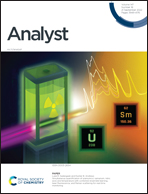DNAzyme recognition triggered cascade signal amplification for rapid and highly sensitive visual detection of uranyl ions†
Abstract
This work presents a rapid and highly sensitive colorimetric assay using bifunctional DNA probe decorated agarose microbeads (MBs) coupled with a cascade signal amplification system, including rolling circle amplification (RCA) and the hemin/G-quadruplex-catalyzed colorimetric reaction, for visualized detection of uranyl ions. The DNA probe integrates the UO22+-specific DNAzyme/substrate as the target recognition unit and a DNA primer as the signal conversion unit. The presence of uranyl ions induces the efficient cleavage of the DNA substrates with the catalysis of DNAzyme. Then the conjugated primers are released from MBs, initiating the RCA reaction (the first amplification). The RCA product consists of repetitive G-quadruplexes that can lead to a second amplification by catalyzing the oxidation of ABTS2− with hemin binding, resulting in a coloration that is visible to the naked eye. The whole assay procedure could be finished within 40 min, including recognition of uranyl and DNA cleavage (5 min), the RCA reaction (30 min) and data readout either by eye or using a UV–vis spectrometer (5 min for each sample). In the optimal conditions, concentrations as low as 5 nM uranyl ions could be distinguished by the naked eye. With UV–vis spectrometric measurement, the visible absorbance had a linear relationship with the concentration of uranyl ions with a dynamic range from 1 nM to 50 nM, and a low detection limit of 0.48 nM (i.e. ∼0.12 ppb) was obtained. Excellent selectivity and anti-interference capability in water samples were also certified. This facile visualized assay could be applied in detecting trace-level uranium for on-site environmental analysis.



 Please wait while we load your content...
Please wait while we load your content...